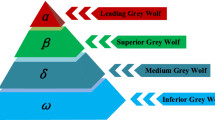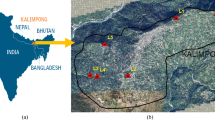Abstract
Slope reliability assessment is an efficient methodology for landslide risk mitigation. However, it is also a challenging task owing to various uncertainties and randomness of soil properties in geotechnical engineering. As the slope is a complicated system with high nonlinearity, the stability analysis with high precision and reliability fails to be obtained from the traditional response surface method. To counteract this limitation, this paper proposes a technique based on machine learning for slope reliability evaluation, namely a multi-objective grey wolf optimization-multi-kernel-based extreme learning machine model based on strength reduction method. The probability of slope failure is estimated by using the developed model when connected with Monte Carlo Simulation. Model application to probabilistic evaluation of slope was conducted by two typical case studies. The results show that as compared with Monte Carlo Simulation and other traditional techniques, the developed machine learning method, which combines the advantages of strength reduction method, the multi-objection grey wolf optimization and multi-kernel-based extreme learning machine, demonstrates better computational performance and applicability, and achieves more accurate and reliable failure probability. Further, the proposed approach can also be applied to predict probability of slope failure with consideration of different coefficient of variation and correlation of soil properties. Hence, improved failure probability can be obtained from the developed method, which could offer crucial information for decisions with regard to early landslide warning.












Similar content being viewed by others
References
Al-Anazi A F. 2011. Support vector machines for petrophysical modelling and lithoclassification
Baecher GB, Christian JT (2003) Reliability and statistics in geotechnical engineering. Wiley, Chichester
Bi WH, Tan XH, Hou XL, Wang J (2010) Reliability analysis of slope based on RBF neural network. Chinese Journal of Underground Space and Engineering 2(06):209–214
Chen C, Wei L, Su HJ, Liu K (2014) Spectral-spatial classification of hyper spectral image based on kernel extreme learning machine. Remote Sens 6(6):5795–5814
Cho SE (2009) Probabilistic stability analyses of slopes using the ANN-based response surface. Comput Geotech 36(5):787–797
Christian JT, Ladd CC, Baecher GB (1994) Reliability applied to slope stability analysis. J Geotech Eng 120(12):2180–2207
Deng J (2006) Structural reliability analysis for implicit performance function using radial basis function network. Int J Solids Struct 43(11–12):3255–3291
Deng ZP, Li QD, Cao ZJ (2017) Slope reliability analysis considering geological uncertainty and spatial variability of soil parameters. Chinese. J Geotech Eng 39(6):986–995
Deng ZP, Pan M, Niu JT (2019) Reliability analysis method of soil slope stability using improved Kriging surrogate model. Journal of Nanchang Institute of Technology 38(6):92–97
Derya A, Akif D (2016) An expert diagnosis system for Parkinson disease based on genetic algorithm-wavelet kernel-extreme learning machine. Parkinsons Disease 2016:1–9
Elhewy AH, Mesbahi E, Pu YC (2006) Reliability analysis of structures using neural network method. Probabilistic Engineering Mechanics 21(1):44–53
Fang KT, Lin DKJ, Winker P, Zhang Y (2000) Uniform design: theory and application. Technometrics 242(3):237–248
Fenton G A, Griffiths D V. 2008. Risk assessment in geotechnical engineering. Geotechnical Special Publication
Goh ATC, Kulhawy FH (2005) Reliability assessment of serviceability performance of braced retaining walls using a neural network approach. Int J Numer Anal Methods Geomech 29(6):627–642
Gomes HM, Awruch AM (2004) Comparison of response surface and neural network with other methods for structural reliability analysis. Structure Safety 26(1):49–67
Griffiths DV, Fenton GA (2004) Probabilistic slope stability analysis by finite elements. J Geotech Geoenviron 130(5):507–518
Griffiths DV, Huang J, Fenton GA (2009) Influence of spatial variability on slope reliability using 2-D random fields. J Geotech Geoenviron 135(10):1367–1378
Hong H, Pourghasemi HR, Pourtaghi ZS (2016) Landslide susceptibility assessment in Lianhua County (China): a comparison between a random forest data mining technique and bivariate and multivariate statistical models. Geomorphology 259(Apr.15):105–118
Huang GB, Zhu QY, Siew CK (2006) Extreme learning machine: theory and applications. Neurocomputing 70:489–501
Huang J, Griffiths DV, Fenton GA (2010) System reliability of slopes by RFEM. Soil Found 50(3):343–353
Huang GB, Zhou H, Ding X, Zhang R (2012) Extreme learning machine for regression and multiclass classification. IEEE Transactions on Systems Man and Cybernetics Part B(Cybernetics) 42(2):513–529
Jaroslav M. 2016. Latin hypercube sampling. Concise Reliability for Engineers
Ji J, Low BK (2012) Stratified response surfaces for system probabilistic evaluation of slopes. J Geotech Geoenviron 138(11):1398–1406
Jiang SH, Li DQ, Cao ZJ, Zhou CB, Phoon KK (2015) Efficient system reliability analysis of slope stability in spatially variable soils using Monte Carlo simulation. J Geotech Geoenviron 141(02):04014096
Kang F, Han S, Salgado R, Li J (2015) System probabilistic stability analysis of soil slopes using Gaussian process regression with Latin hypercube sampling. Comput Geotech 63:13–25
Kang F, Xu Q, Li JJ (2016) Slope reliability analysis using surrogate models via new support vector machines with swarm intelligence. Appl Math Model 40(11–12):6105–6120
Kang F, Li JS, Wang Y, Li JJ (2017) Extreme learning machine-based surrogate model for analyzing system reliability of soil slopes. Eur J Environ Civ Eng 21(11):1341–1362. https://doi.org/10.1080/19648189.2016.1169225
Karaboga D, Akay B (2009) A comparative study of artificial bee colony algorithm. Appl Math Comput 214(1):108132
Karaboga D, Gorkemli B, Ozturk C, Karaboga N (2014) A comprehensive survey: artificial bee colony (ABC) algorithm and applications. Artif Intell Rev 42(1):21–57
Lacasse S, Nadim F (1996) Uncertainties in characterizing soil properties. Geotechnical Special Publication 58 I:49–75
Li DQ, Chen YF, Lu WB, Zhou C (2011) Stochastic response surface method for reliability analysis of rock slopes involving correlated non-normal variables. Comput Geotech 38(1):58–68
Li QD, Jiang SH, Zhou CB (2013) Reliability analysis of slopes considering spatial variability of soil parameters using non-intrusive stochastic method. Chinese Journal of Geotechnical Engineering 35(8):1413–1422
Liu X, Tang HM, Xiong CR (2013) Patterns, problems, and development trends of analysis methods for slope dynamic reliability. Rock Soil Mech 34(5):1217–1234
Low BK, Tang WH (2007) Efficient spreadsheet algorithm for first-order reliability method. J Eng Mech 133(12):1378–1387
Low BK, Zhang J, Tang WH (2011) Efficient system reliability analysis illustrated for a retaining wall and a soil slope. Comput Geotech 38:196–204
Mirjalili S, Mirjalili SM, Lewis A (2014) Grey wolf optimizer. Advances in Engineering Software 69:46–61. https://doi.org/10.1016/j.advengsoft.2013.12.007
Petley D (2012) Global patterns of loss of life from landslides. Geology 40(10):927–930
Ranjeeta B, Dash P K, Das P P. 2018. Short-term electricity price forecasting and classification in smart grids using optimized multikernel extreme learning machine. Neural Comput Appl 1-24
Ranjeeta B, Dash PK, Parida AK (2019) Hybrid Variational mode decomposition and evolutionary robust kernel extreme learning machine for stock price and movement prediction on daily basis. Appl Soft Comput 74:652–678
Santoso AM, Phoon KK, Quek ST (2011) Effects of soil spatial variability on rainfall-induced landslides. Comput Geotech 89(11–12):893–900
Sastry VVRN, Meyerhof GG (1999) Flexible piles in layered soil under eccentric and inclined loads. Soils Found 39(1):11–20
Seeger M (2004) Gaussian processes for machine learning. International Journal of Neural System 14(2):69–106
Smola AJ, Schölkopf B. 1998. Learning with kernels. MIT
Smola AJ, Schölkopf B (2004) A tutorial on support vector regression. Stat Comput 14:199–222
Song YD, Su LJ, Zhang CL, Sun CN, Qu X (2018) Reliability analysis of slopes based on extreme learning machine. Journal of Yangtze River Scientific Research Institute 35(08):82–87
Su GS, Song YC, Yan LB (2009) Application of Gaussian process machine learning to slope stability evaluation. Rock and Soil Mechanics 30(03):103–107 +115
Su GS, Zhao W, Peng LF, Yan LB (2014) Gaussian process-based dynamic response surface method for estimating slope failure probability. Rock Soil Mech 35(12):3592–3601
Tan XH, Wang JG, Wu LN, Cui KR, Chu CF (2007) Limit step length iteration method in finite element reliability analysis of slope stability. Chin J Rock Mech Eng 26(suppl.1):2901–2906
Wang M, Chen JHL, Li HZ, Cai ZN, Zhao XH, Tong CF, Li J, Xu X (2017) Grey wolf optimization evolving kernel extreme learning machine: application to bankruptcy prediction. Eng Appl Artif Intell 63:54–68
Wu ZJ, Wang SL, Tang H, Ge XR (2010) A new sensitivity analysis approach for slope stability-reliability analysis method. Chinese Journal of Rock Mechanics and Engineering 29(10):2050–2055
Zhang J, Huang HW, Juang CH, Li DQ (2013) Extension of Hassan and Wolff method for system reliability analysis of soil slopes. Eng Geol 160:81–88
Zhao HB (2008) Slope reliability analysis using a support vector machine. Comput Geotech 35(3):459–467
Zhou C, Yin KL, Cao Y, Intrieri E, Ahmed B, Catani F (2018) Displacement prediction of step-like landslide by applying a novel kernel extreme learning machine method. Landslides 15:2211–2225
Zhu B, Pei HF, Yang Q (2019) Gaussian process regression-based response surface method and reliability analysis of slopes. Chinese Journal of Geotechnical Engineering 41(S1):209–212
Acknowledgments
The authors would like to thank the reviewers for the constructive comments and suggestions.
Funding
The authors wish received financial the support from the following: (i) National Key R&D Program (project no. 2018YFC1505100); (ii) National Natural Science Foundation of China (NSFC) (project nos: 41731066, 41674001, 41790445); (iii) the PhD Foundation (no. 061801).
Author information
Authors and Affiliations
Corresponding author
Rights and permissions
About this article
Cite this article
Ling, Q., Zhang, Q., Wei, Y. et al. Slope reliability evaluation based on multi-objective grey wolf optimization-multi-kernel-based extreme learning machine agent model. Bull Eng Geol Environ 80, 2011–2024 (2021). https://doi.org/10.1007/s10064-020-02090-5
Received:
Accepted:
Published:
Issue Date:
DOI: https://doi.org/10.1007/s10064-020-02090-5




